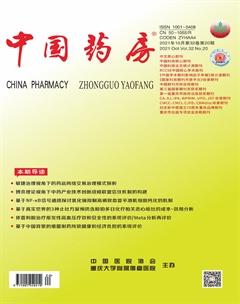多西他赛PELGE纳米粒的处方优化、表征及其体外释放和抗肿瘤活性的初步评价
廖龙飞 杨青青 漆婷婷 邱悦 肖洪涛



中图分类号 R943;R944.9 文献标志码 A 文章编号 1001-0408(2021)20-2492-07
DOI 10.6039/j.issn.1001-0408.2021.20.10
摘 要 目的:优化多西他赛(DTX)-聚乙二醇-(聚乳酸-羟基乙酸)-聚乙二醇三嵌段共聚物(PELGE)-纳米粒(NPs)的处方,对其进行表征,并评价其体外释放特性及抗肿瘤活性。方法:采用开环共聚法合成PELGE,采用乳化溶剂挥发法制备DTX-PELGE- NPs;采用高效液相色谱法测定DTX-PELGE-NPs中DTX的含量;以DTX用量、PELGE用量、泊洛沙姆188濃度为自变量,包封率为因变量,采用Box-Behnken设计-响应面法优化处方;采用激光粒度仪和透射电镜测定DTX-PELGE-NPs的粒度和Zeta电位;以DTX注射液为参照,采用离心超滤法测定体外释放率;以DTX注射液不含DTX的PELGE-NPs为参照,采用噻唑蓝法考察体外细胞毒性。结果:最优处方为DTX用量2.80 mg,PELGE用量20.60 mg,泊洛沙姆188浓度6%。优化所得DTX-PELGE-NPs的包封率为(86.79±1.32)%,载药量为(10.21±0.78)%,平均粒度为(78.4±2.9)nm,多分散性指数(PDI)为(0.187±0.018),Zeta电位为(-20.6±1.5)mV;电镜下DTX-PELGE-NPs呈类球形,分布均匀。相较于DTX注射液(4 h时的累积释放率约为92.3%),DTX-PELGE-NPs有明显的缓释效果(36 h时的累积释放率约为78.6%)。0.1~50 μg/mL的PELGE-NPs对人乳腺癌细胞MCF-7无明显细胞毒性(P>0.05),而0.5~10 μg/mL的 DTX-PELGE-NPs能够显著抑制人乳腺癌细胞MCF-7的生长,且作用(DTX-PELGE- NPs 10 μg/mL组除外)显著强于同浓度DTX注射液(P<0.05)。结论:优化所得处方工艺稳定、可行;所得DTX-PELGE-NPs粒度均匀,包封率较高,缓释效果明显,体外抗肿瘤活性强于DTX注射液。
关键词 多西他赛;聚乙二醇-(聚乳酸-羟基乙酸)-聚乙二醇三嵌段共聚物;Box-Behnken设计-响应面法;高效液相色谱法;处方优化
Formulation Optimization and Characterization of Docetaxel PELGE Nanoparticles and Preliminarily Evaluation of Its Drug Release and Antitumor Activity in vitro
LIAO Longfei1,YANG Qingqing2,QI Tingting1,QIU Yue1,XIAO Hongtao1(1. Dept. of Clinical Pharmacy, Sichuan Cancer Hospital/Sichuan Cancer Prevention and Control Center/the Affiliated Cancer Hospital of University of Electronic Science and Technology of China, Chengdu 610041, China; 2. Patent Examination Cooperation Sichuan Center, the Patent Office of CNIPA, Chengdu 610200, China)
ABSTRACT OBJECTIVE: To optimize the formulation of docetaxel (DTX)-mPEG-PLGA-mPEG (PELGE)-nanoparticles (NPs), and to characterize it and evaluate its in vitro drug release and antitumor activity. METHODS: PELGE were synthesized by ring-opening polymerization. DTX-PELGE-NPs were prepared by using emulsion solvent evaporation method. The content of DTX in DTX-PELGE-NPs was determined by HPLC. Box-Behnken design-response surface methodology was applied to optimize the formulation of the nanoparticles using the amount of DTX, PELGE and poloxamer 188 as independent variable, using entrapped efficiency as dependent variable. The particle size and Zeta-potential of DTX-PELGE-NPs were characterized by laser particle size analyzer and transmission electron microscope. The in vitro release of the DTX-PELGE-NPs was investigated by ultra-filtered centrifugation, using DTX injection as reference. In vitro cytotoxicity of the DTX-PELGE-NPs was investigated by MTT assay, using DTX and PELGE-NPs without DTX as reference. RESULTS: The optimal formulation included 2.80 mg DTX, 20.60 mg PELGE and 6% poloxamer 188. The entrapped efficiency of optimized DTX-PELGE-NPs was (86.79±1.32)%; drug-loading amount was (10.21±0.78)%, and average particle size was (78.4±2.9)nm; polydispersity coefficient was (0.187±0.018) and Zeta potential was (-20.6±1.5) mV. Furthermore, DTX- PELGE-NPs showed a regular spherical and uniform distribution under scanning electron microscopy. Compared with DTX injection (accumulative release rate of 92.3% at 4 h), DTX- PELGE-NPs had a significant sustained-release effect (accumu- lative release rate of 78.6% at 36 h). 0.1-50 μg/mL PELGE-NPs had no obvious cytotoxicity to human breast cancer cells MCF-7 (P>0.05). 0.5-10 μg/mL DTX-PELGE-NPs could significantly inhibit the growth of human breast cancer cells MCF-7, and its inhibitory effect (except for DTX-PELGE-NPs 10 μg/mL group) was significantly stronger than that of DTX injection (P<0.05). CONCLUSIONS: The optimized formulation is stable and feasible. The obtained DTX-PELGE-NPs not only have uniform particle size, high encapsulation rate obvious slow-release effect, but also have stronger anti-tumor effect in vitro than DTX injection.

